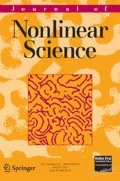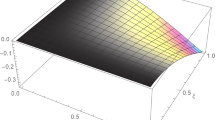Abstract
We study the long-time asymptotic behavior of oscillatory Riemann–Hilbert problems (RHPs) arising in the mKdV hierarchy (reducing from the AKNS hierarchy). Our analysis is based on the idea of \({\bar{\partial }}\)-steepest descent. We consider RHPs generated from the inverse scattering transform of the AKNS hierarchy with weighted Sobolev initial data. The asymptotic formula for three regions of the spatial- and temporal-dependent variables is presented in details.









Similar content being viewed by others
Notes
Due to Zhou’s theorem (Zhou 1998), R(z) belongs to \(H^{1,n-1}(dz)\), then the time evolving reflection coefficient \(R(z)e^{\pm 2it\theta }\) will stay in \(H^{1,1}(\mathrm{d}z)\) since the degree of \(\theta \) is n.
This guarantees the time evolving of the initial data will stay in \(H^{1,1}\). Roughly speaking, from Zhou’s work, we know \(q(x,0)\in H^{n-1,1}\subset H^{1,1}\) is mapped to \(R(z)\in H^{1,n-1}\). Time evolution of the reflection coefficient gives \(R(z)e^{itz^n}\), which belongs to \(H^{1,1}\) due to the fact that \(R(z)\in H^{1,n-1}\), and then the inverse scattering leads to \(q(x,t)\in H^{1,n-1}\).
A good summary of this method can be found in Deift et al. (1993).
Here, \(R(z)\in C^1({\mathbb {R}})\) means R(z) is a function defined on the real line with continuous first-order derivative. While since O(z) is a matrix-valued function defined on the complex plan, so \(O(z)\in C^1({\mathbb {R}}^2)\) means all the entries have continuous first-order derivatives with respect to z and \({\bar{z}}\).
In the middle steps, c means a generic positive constant.
The existence and uniqueness will be discussed later.
Here the \(L^\infty (\Sigma )\) norm \(\Vert f(z)\Vert _{\infty }\) means \(\sup _{z\in \Sigma }|f(z)|\), where \(|f(z)|=\max _{i,j=1,2,z\in \Sigma }|f_{i,j}(z)|\).
\((w^-,w^+)\) will be called the factorization data for the jump matrix.
Here, \(w=w^++w^-\).
The fact is nontrivial, but the derivation is in Deift and Zhou (1993), see equation (4.47)
Surprisingly, the dependence on \(p_j,q_j\) will disappear.
Such a choice of \(\alpha \) guarantees that the new contours will stay within the regions where the corresponding exponential term will decay (considering Fig. 7).
As for the existence of the RHP \(m^{[3]}\), which is not completely trivial due to the fact that solutions to the Painlevé II equations have poles, we refer the readers to the book (Fokas et al. 2006) for the details
References
Ablowitz, M.A., Clarkson, P.A.: Solitons, Nonlinear Evolution Equations and Inverse Scattering. London Mathematical Society Lecture Note Series, Cambridge University Press, Cambridge (1991)
Ablowitz, M.J., Segur, H.: Exact linearization of a Painlevé transcendent. Phys. Rev. Lett. 38, 1103–1106 (1977)
Beals, R., Coifman, R.R.: Scattering and inverse scattering for first order systems. Commun. Pure Appl. Math. 37(1), 39–90 (1984)
Beals, R., Deift, P., Tomei, C.: Direct and Inverse Scattering on the Line. American Mathematical Society, Providence (1988)
Borghese, M., Jenkins, R., McLaughlin, K.D.-R.: Long time asymptotic behavior of the focusing nonlinear Schrödinger equation. Annales de l’Institut Henri Poincaré C, Analyse non linéaire 35(4), 887–920 (2018)
Cafasso, M., Claeys, T., Girotti, M.: Fredholm determinant solutions of the Painlevé II hierarchy and gap probabilities of determinantal point processes. Int. Math. Res. Not. 2021(4), 2437–2478 (2019)
Chen, G., Liu, J.: Long-time asymptotics of the modified KdV equation in weighted Sobolev spaces (2019). arXiv: 1903.03855
Chen, G., Liu, J., Lu, B.: Long-time asymptotics and stability for the sine-Gordon equation (2020). arXiv: 2009.04260
Claeys, T., Krasovsky, I., Its, A.: Higher-order analogues of the Tracy–Widom distribution and the Painlevé II hierarchy. Commun. Pure Appl. Math. 63(3), 362–412 (2010)
Clarkson, P., Joshi, N., Mazzocco, M.: The Lax pair for the mKdV hierarchy. Théories Asymptotiques Et équations De Painlevé, Sémin. Congr 14, 53–64 (2006)
Clarkson, P.A., Joshi, N., Pickering, A.: Bäcklund transformations for the second Painlevé hierarchy: a modified truncation approach. Inverse Probl 15(1), 175–187 (1999)
Deift, P., Kriecherbauer, T., McLaughlin, K.-R.: New results on the equilibrium measure for logarithmic potentials in the presence of an external field. J. Approx. Theory 95(3), 388–475 (1998)
Deift, P., Kriecherbauer, T., McLaughlin, K.T.-R., Venakides, S., Zhou, X.: Strong asymptotics of orthogonal polynomials with respect to exponential weights. Commun. Pure Appl. Math. 52(12), 1491–1552 (1999)
Deift, P., Zhou, X.: A steepest descent method for oscillatory Riemann–Hilbert problems. Asymptotics for the MKdV equation. Ann. Math. 137(2), 295–368 (1993)
Deift, P., Zhou, X.: Long-time asymptotics for solutions of the NLS equation with initial data in a weighted Sobolev space. Commun. Pure Appl. Math. 56(8), 1029–1077 (2003)
Deift, P.A., Its, A.R., Zhou, X.: Long-Time Asymptotics for Integrable Nonlinear Wave Equations. Springer Series in Nonlinear Dynamics Important Developments in Soliton Theory, pp. 181–204. Springer, Berlin (1993)
Dieng, M., McLaughlin, K.D.T.R.: Long-time asymptotics for the NLS equation via dbar methods (2008). arXiv:0805.2807
Dieng, M., McLaughlin, K.D.T.R., Miller, P.D.: Dispersive asymptotics for linear and integrable equations by the \(\overline{\partial }\) steepest descent method (2018). arXiv: 1809.01222
Do, Y.: A nonlinear stationary phase method for oscillatory Riemann–Hilbert problems. Int. Math. Res. Not. 2011(12), 2650–2765 (2010)
Fokas, A.S., Its, A.R., Novokshenov, V.Y., Kapaev, A.A., Kapaev, A.I., Novokshenov, V.Y.: Painlevé Transcendents: The Riemann–Hilbert Approach, vol. 128. American Mathematical Society, Providence (2006)
Giavedoni, P.: Long-time asymptotic analysis of the Korteweg–de Vries equation via the dbar steepest descent method: the soliton region. Nonlinearity 30(3), 1165 (2017)
Its, A.R.: Asymptotics of solutions of the nonlinear schrodinger equation and isomonodromic deformations of systems of linear differential equations. Doklady Akademii Nauk 261(1), 14–18 (1981)
Liu, N., Chen, M., Guo, B.: Long-time asymptotic behavior of the fifth-order modified KdV equation in low regularity spaces (2019). arXiv:1912.05342
Ma, W.X.: A soliton hierarchy associated with \(so(3,{\mathbb{R}})\). Appl. Math. Comput. 220, 117–122 (2013)
Ma, W.X.: Long-time asymptotics of a three-component coupled mKdV system. Mathematics 7(7), 573 (2019)
Ma, W.X.: Long-time asymptotics of a three-component coupled nonlinear Schrödinger system. J. Geom. Phys. 153, 103669 (2020)
McLaughlin, K.T.R., Miller, P.D.: The dbar steepest descent method and the asymptotic behavior of polynomials orthogonal on the unit circle with fixed and exponentially varying nonanalytic weights (2004). arXiv: math/040648
Miller, P.D., Sheng, Y.: Rational solutions of the Painlevé-II equation revisited. Symmetry Integr. Geom. Methods Appl. 13, 065 (2017)
Tu, G.: The trace identity, a powerful tool for constructing the Hamiltonian structure of integrable systems. J. Math. Phys. 30(2), 330–338 (1989)
Varzugin, G.: Asymptotics of oscillatory Riemann–Hilbert problems. J. Math. Phys. 37, 5869–5892 (1996)
Zhou, X.: \(L^2\)-Sobolev space bijectivity of the scattering and inverse scattering transforms. Commun. Pure Appl. Math. 51(7), 697–731 (1998)
Author information
Authors and Affiliations
Corresponding authors
Additional information
Communicated by Peter Miller.
Publisher's Note
Springer Nature remains neutral with regard to jurisdictional claims in published maps and institutional affiliations.
Rights and permissions
About this article
Cite this article
Wang, F., Ma, WX. A \({\bar{\partial }}\)-Steepest Descent Method for Oscillatory Riemann–Hilbert Problems. J Nonlinear Sci 32, 10 (2022). https://doi.org/10.1007/s00332-021-09765-7
Received:
Accepted:
Published:
DOI: https://doi.org/10.1007/s00332-021-09765-7




